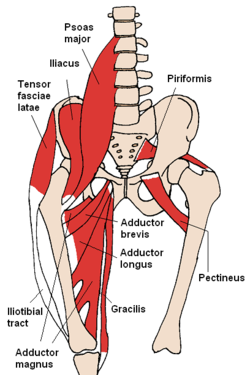Iliopsoas muscle
| Iliopsoas (hip flexor) | |
|---|---|

Anterior hip muscles. The iliopsoas is not labeled but can be seen as the psoas major and the iliacus join inferiorly.
|
|
| Details | |
| Origin | Iliac fossa and lumbar spine |
| Insertion | Lesser trochanter of femur |
| Artery | Medial femoral circumflex artery and iliolumbar artery |
| Nerve | Branches from L1 to L3 |
| Actions | Flexion of hip |
| Antagonist | Gluteus maximus and the posterior compartment of thigh |
| Identifiers | |
| Latin | Musculus iliopsoas |
| Dorlands /Elsevier |
m_22/12549330 |
| TA | A04.7.02.002 |
| FMA | 64918 |
|
Anatomical terms of muscle
[]
|
|
The iliopsoas (ilio-so-as) is the combination of the psoas major and the iliacus at their inferior ends. These muscles are distinct in the abdomen, but usually indistinguishable in the thigh. As such, they are usually given the common name iliopsoas and are referred to as the "dorsal hip muscles". or "inner hip muscles". The psoas minor does contribute to the iliopsoas muscle.
The psoas major originates along the lateral surfaces of the vertebral bodies of T12 and L1-L3 and their associated intervertebral discs. The iliacus originates in the iliac fossa of the pelvis.
The psoas major unites with the iliacus at the level of the inguinal ligament and crosses the hip joint to insert on the lesser trochanter of the femur. The iliopsoas is involved in flexion and lateral rotation (supination) of the thigh. If the limb is fixed they involve in flexion of the trunk.
It is a composite muscle. The psoas major is innervated by direct branches of the anterior rami off the lumbar plexus at the levels of L1-L3, while the iliacus is innervated by the femoral nerve (which is composed of nerves from the anterior rami of L2-L4).
The iliopsoas is the strongest of the hip flexors (others are rectus femoris, sartorius, and tensor fasciae latae). The iliopsoas is important for standing, walking, and running. The iliacus and psoas major perform different actions when postural changes occur.
...
Wikipedia
